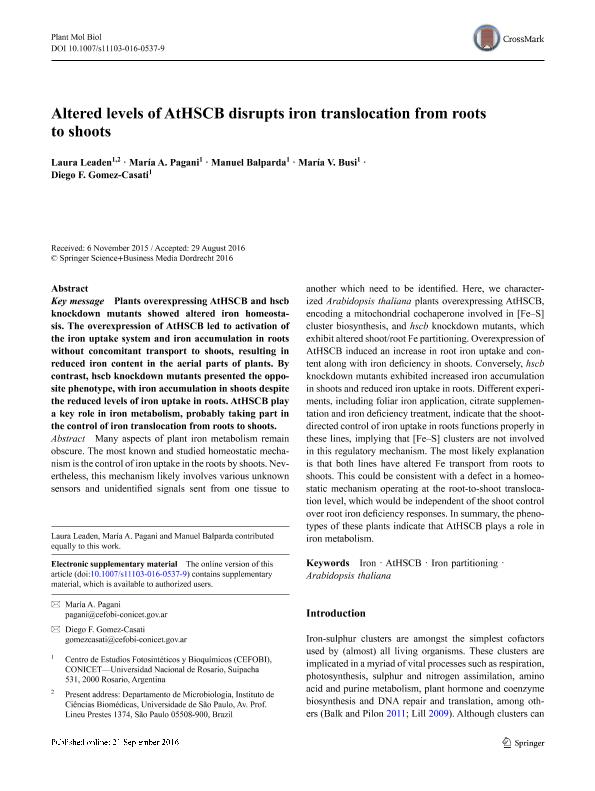Artículo
Altered levels of AtHSCB disrupts iron translocation from roots to shoots
Leaden, Laura ; Pagani, María Ayelén
; Pagani, María Ayelén ; Balparda, Manuel
; Balparda, Manuel ; Busi, María Victoria
; Busi, María Victoria ; Gomez Casati, Diego Fabian
; Gomez Casati, Diego Fabian
 ; Pagani, María Ayelén
; Pagani, María Ayelén ; Balparda, Manuel
; Balparda, Manuel ; Busi, María Victoria
; Busi, María Victoria ; Gomez Casati, Diego Fabian
; Gomez Casati, Diego Fabian
Fecha de publicación:
11/2016
Editorial:
Springer
Revista:
Plant Molecular Biology
ISSN:
0167-4412
Idioma:
Inglés
Tipo de recurso:
Artículo publicado
Clasificación temática:
Resumen
Key message: Plants overexpressing AtHSCB and hscb knockdown mutants showed altered iron homeostasis. The overexpression of AtHSCB led to activation of the iron uptake system and iron accumulation in roots without concomitant transport to shoots, resulting in reduced iron content in the aerial parts of plants. By contrast, hscb knockdown mutants presented the opposite phenotype, with iron accumulation in shoots despite the reduced levels of iron uptake in roots. AtHSCB play a key role in iron metabolism, probably taking part in the control of iron translocation from roots to shoots. Abstract: Many aspects of plant iron metabolism remain obscure. The most known and studied homeostatic mechanism is the control of iron uptake in the roots by shoots. Nevertheless, this mechanism likely involves various unknown sensors and unidentified signals sent from one tissue to another which need to be identified. Here, we characterized Arabidopsis thaliana plants overexpressing AtHSCB, encoding a mitochondrial cochaperone involved in [Fe–S] cluster biosynthesis, and hscb knockdown mutants, which exhibit altered shoot/root Fe partitioning. Overexpression of AtHSCB induced an increase in root iron uptake and content along with iron deficiency in shoots. Conversely, hscb knockdown mutants exhibited increased iron accumulation in shoots and reduced iron uptake in roots. Different experiments, including foliar iron application, citrate supplementation and iron deficiency treatment, indicate that the shoot-directed control of iron uptake in roots functions properly in these lines, implying that [Fe–S] clusters are not involved in this regulatory mechanism. The most likely explanation is that both lines have altered Fe transport from roots to shoots. This could be consistent with a defect in a homeostatic mechanism operating at the root-to-shoot translocation level, which would be independent of the shoot control over root iron deficiency responses. In summary, the phenotypes of these plants indicate that AtHSCB plays a role in iron metabolism.
Palabras clave:
Arabidopsis Thaliana
,
Athscb
,
Iron
,
Iron Partitioning
Archivos asociados
Licencia
Identificadores
Colecciones
Articulos(CEFOBI)
Articulos de CENTRO DE EST.FOTOSINTETICOS Y BIOQUIMICOS (I)
Articulos de CENTRO DE EST.FOTOSINTETICOS Y BIOQUIMICOS (I)
Citación
Leaden, Laura; Pagani, María Ayelén; Balparda, Manuel; Busi, María Victoria; Gomez Casati, Diego Fabian; Altered levels of AtHSCB disrupts iron translocation from roots to shoots; Springer; Plant Molecular Biology; 92; 4-5; 11-2016; 613-628
Compartir
Altmétricas



